Sewage replacement: work performance technology
In the past, cast iron pipes were commonly used for drainage, this material is good, but not eternal. In particular, the sewage system of most of the prefabricated houses built in the 2nd half of the last century is in a deplorable state. Therefore, in our days it becomes urgent to replace sewage in the Khrushchev own hands.
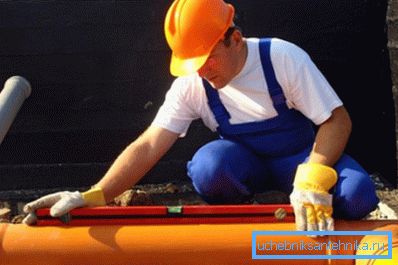
Scope of work when replacing sewage
For residents of city apartments, this is usually limited to dismantling old horizontal pipes connecting plumbing fixtures to the riser.
The work is performed in the following sequence:
- at the time of work in the house is established "dry law";
- sanitary devices are disconnected from the drainage system;
- after that comes the turn of the most time-consuming operation - removal of horizontal pipes. If they were laid in a subfield or in a special box, then you can do it quickly. But if they fit into the screed or embedded in the wall, using a perforator and grinders, you need to remove the layer of concrete;
- special attention and accuracy must be shown when removing the area connected to the riser;
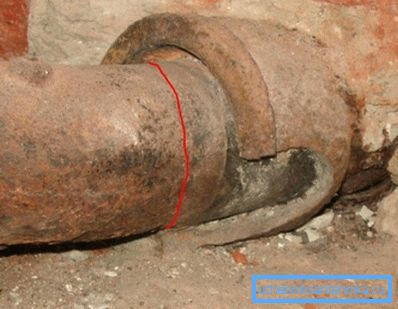
- a new pipeline is laid, the tightness of the system is checked, then they are hidden in a wall or in the floor.
If the replacement is carried out in a private house, then in addition to interior work, an external sewage system will be required. This is associated with certain difficulties - the volume of earthworks is significant, and the layout of the site may not allow the use of special equipment for digging trenches. In this regard, the trenchless method of laying a new pipeline is quite popular.
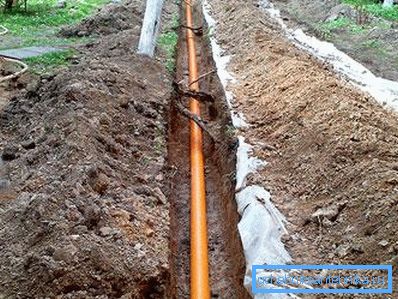
Work execution technology
If the work will be performed in a city apartment, before starting, you need to ask the neighbors above to refrain from using the sewer for a while. And it is better to simply turn off the water supply.
In the future, instructions for the work looks like this:
- cut off the visible part of the pipe after turning off the plumbing fixture;
Note! When working in the bathroom siphon need to knock out carefully. If the bath itself is cast-iron, then it can be easily split with a careless blow of a hammer.
- removal of the old pipeline is best done in parts, making cuts grinder. As a rule, it is not immediately possible to cut through the metal to the full depth; therefore, you can first make a small cut and bring the wall inside with a hammer blow. After that, the disc will reach the far wall;
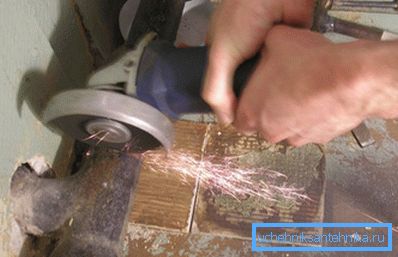
- after the removal of the pipeline, discharging the effluent into the riser, you can start laying a new one.
Features dismantling the old sewer
The hardest thing to dismantle so as not to damage the socket. If the slightest crack is formed in the riser, it is necessary to change it, the cost of updating the sewage system in this case will only increase.
Note! When removing a section of the sewage system suitable for the riser, it is strictly forbidden to rock it. Cast iron is a very fragile material and cracks can form at the socket because of this.
In the past, when joining with a socket, for additional sealing, the free space at the junction was filled with sulfur or filled with cement mortar. Over the years of operation, the riser was most likely painted more than once, so you first need to remove a layer of paint and excess sealant.
The first step is to remove excess sealing material. An ordinary screwdriver or a chisel and a hammer are suitable for this. Gently tapping on the screwdriver to chop off extra material.

Then you need to remove the sealing material from the space between the walls of the pipes.
There are several ways to do this:
- using a drill - frozen sulfur is simply drilled;
- by heating the joint - while sulfur burns out, it is absolutely safe for cast iron.
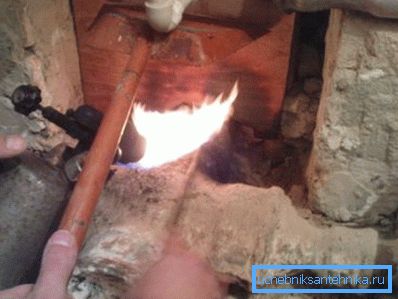
Note! When burning, a lot of harmful gases are formed, so you need to organize good ventilation and equip yourself with personal respiratory protection equipment.
Dismantling the old riser
A rotten riser is capable of delivering a lot of headaches, however, and its replacement can be managed on its own.

Instructions for installing a new riser instead of cast iron looks like this (it is assumed that the horizontal pipeline has already been removed):
- removed part of the old riser. From the ceiling you need to retreat about 10 cm and make an incision with a grinder, the same incision will be needed in the lower part - above the distribution sewer tee;
- the chisel is gently pushed into the cut, due to the slight bending of the pipe, the cast iron bursts. As a rule, the fault line is perfectly flat;
- if a piece of pipe going to the tee looks reliable and does not falter, then it can be left, otherwise it is better to cut it together with the tee (the cut should go below the lower bell). The tee trumpet is peeled;
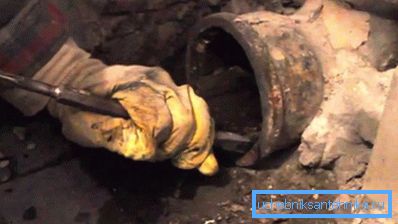
- After that, you can proceed to the installation of a plastic riser.
Installing a new riser
When connecting the plastic riser with cast-iron pipes, a special rubber cuff is used for additional tightness of the joint. The rest of the connection process is not much different from a simple bell-shaped connection.
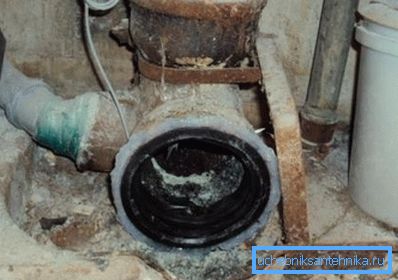
First, a rubber cuff is inserted into the carefully cleaned socket and only after that the pipes are connected. Additionally, the compound is abundantly sealed with a sealant.
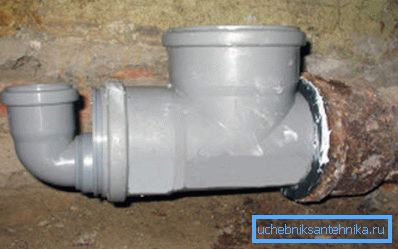
Since only part of the riser is changed, the last connection of the pipes is performed end-to-end, and the tightness of the connection is achieved by means of an adapter.
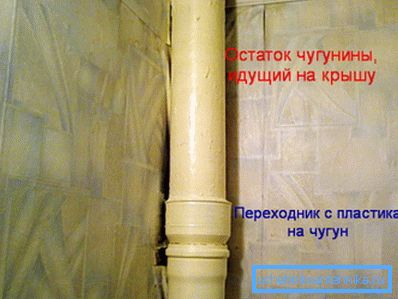
Replacement of external sewage
This part applies only to owners of private homes. The cost of replacing an external sewage system is not so high, but the process itself is quite laborious, because you will have to perform a large amount of earthworks.
The solution in this situation could be a trenchless way of pipe replacement. If, with the open method, you need to dig a trench and remove the old pipe, then with the closed one, you can do without digging ditches
Free flow sewage
Most private homes have just such a system of drainage. All work is performed by a special mechanism that destroys the old pipe, slightly expands the diameter of the hole and seals its walls.
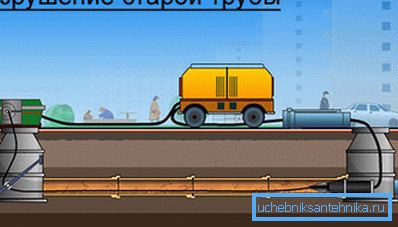
Replacement of pipes is performed in areas between wells.
When replacing drainage with a trenchless method, the work is performed in the following order:
- a pneumatic punch equipped with an expander and a destroyer moves to the end point along the old pipe;
- the pipe that has served its end collapses, and at the same time, the walls of the resulting tunnel are compacted due to the expander;
- after the punch, the pipeline is immediately guided, the sections of which are connected by a threaded connection.
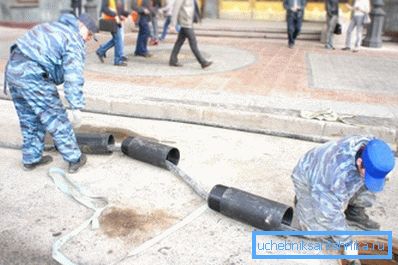
The price is, of course, higher than when replacing pipes in the traditional way. But, given the time savings and quality of work, this method deserves attention.
Pressure sewage
The principle of operation remains the same - the new pipeline is being pulled along the old route without digging trenches. The main difference from the replacement of free-flow sewage is that the old pipeline does not collapse.
That is, a new pipe of a slightly smaller diameter is simply pulled through the old sewer. Given that the diameter is reduced, this method cannot be used for free-flow sewage. Due to the reduction in diameter, the throughput will also decrease, which means that the likelihood of clogging will increase.
In pressure systems, a reduction in cross section can be compensated for by a slight increase in pressure. Therefore, this method is not used to replace sewage systems in private homes.

Compared with the destruction of the old pipeline, this method has the advantage that the new pipe can be pulled not only in the areas between the wells, but also along an inclined line, that is, from the surface. In addition, the old pipeline will provide additional protection.
Summarizing
Replacing the drainage system is an integral part of the overhaul, especially if old cast-iron pipes were used to drain drains. The task is not so difficult as it seems at first glance, and it can be greatly simplified. For example, when upgrading a drainage system, the trenchless sewage replacement will allow you to quickly cope with work outside the home, and you can cope with the internal system on your own.
The video in this article focuses on the internal work of replacing the sewer.